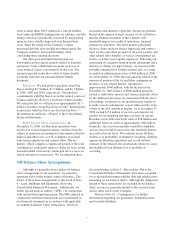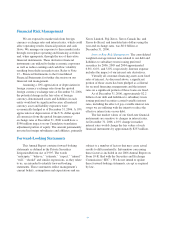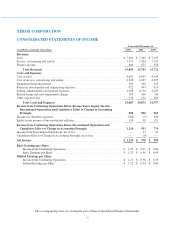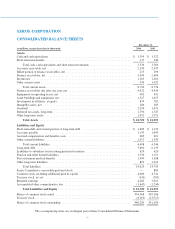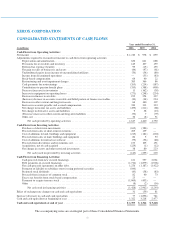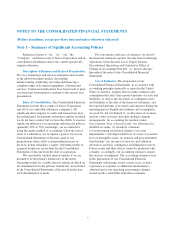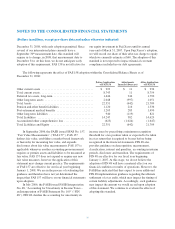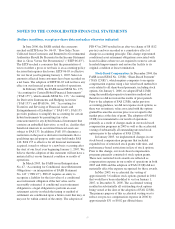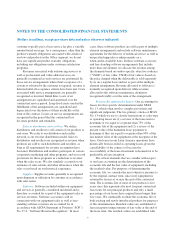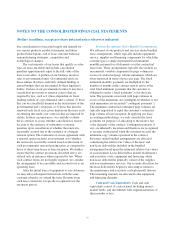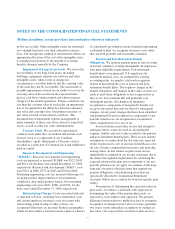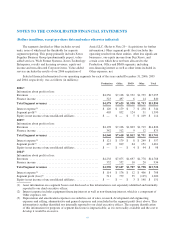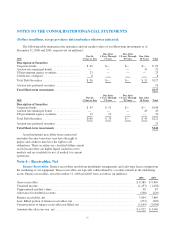Xerox 2006 Annual Report Download - page 59
Download and view the complete annual report
Please find page 59 of the 2006 Xerox annual report below. You can navigate through the pages in the report by either clicking on the pages listed below, or by using the keyword search tool below to find specific information within the annual report.NOTES TO THE CONSOLIDATED FINANCIAL STATEMENTS
(Dollars in millions, except per-share data and unless otherwise indicated)
In June 2006, the FASB ratified the consensus
reached on EITF Issue No. 06-03, “How Sales Taxes
Collected from Customers and Remitted to Governmental
Authorities Should Be Presented in the Income Statement
(that is, Gross Versus Net Presentation)” (“EITF 06-03”).
The EITF reached a consensus that the presentation of
taxes on either a gross or net basis is an accounting policy
decision that requires disclosure. EITF 06-03 is effective
for our fiscal year beginning January 1, 2007. Sales tax
amounts collected from customers have been recorded on
a net basis. The adoption of EITF 06-03 will not have any
effect on our financial position or results of operations.
In February 2006, the FASB issued SFAS No. 155,
“Accounting for Certain Hybrid Financial Instruments”
(“FAS 155”), which amends SFAS No. 133, “Accounting
for Derivative Instruments and Hedging Activities”
(“FAS 133”) and SFAS No. 140, “Accounting for
Transfers and Servicing of Financial Assets and
Extinguishments of Liabilities” (“FAS 140”). FAS 155
provides guidance to simplify the accounting for certain
hybrid instruments by permitting fair value
remeasurement for any hybrid financial instrument that
contains an embedded derivative, as well as, clarifies that
beneficial interests in securitized financial assets are
subject to FAS 133. In addition, FAS 155 eliminates a
restriction on the passive derivative instruments that a
qualifying special-purpose entity may hold under FAS
140. FAS 155 is effective for all financial instruments
acquired, issued or subject to a new basis occurring after
the start of our fiscal year beginning January 1, 2007. We
believe that the adoption of this statement will not have a
material effect on our financial condition or results of
operations.
In March 2005, the FASB issued Interpretation
No. 47, “Accounting for Conditional Asset Retirement
Obligations – an interpretation of FASB Statement
No. 143” (“FIN 47”). FIN 47 requires an entity to
recognize a liability for the fair value of a conditional
asset retirement obligation if the fair value can be
reasonably estimated. A conditional asset retirement
obligation is a legal obligation to perform an asset
retirement activity in which the timing or method of
settlement are conditional upon a future event that may or
may not be within control of the entity. The adoption of
FIN 47 in 2005 resulted in an after-tax charge of $8 ($12
pre-tax) and was recorded as a cumulative effect of
change in accounting principle. This charge represented
conditional asset retirement obligations associated with
leased facilities where we are required to remove certain
leasehold improvements and restore the facility to its
original condition at lease termination.
Stock-Based Compensation: In December 2004, the
FASB issued SFAS No. 123(R), “Share-Based Payment”
(“FAS 123(R)”), which requires companies to recognize
compensation expense using a fair value based method for
costs related to all share-based payments, including stock
options. On January 1, 2006, we adopted FAS 123(R)
using the modified prospective transition method and
therefore we did not restate the results of prior periods.
Prior to the adoption of FAS 123(R), under previous
accounting guidance, we did not expense stock options, as
there was no intrinsic value associated with the options
granted because the exercise price was set equal to the
market price at the date of grant. The adoption of FAS
123(R) was immaterial to our results of operations
primarily as a result of changes made in our stock-based
compensation programs in 2005 as well as the accelerated
vesting of substantially all outstanding unvested stock
options prior to the adoption of FAS 123(R).
In January 2005, we implemented changes in our
stock-based compensation programs that included
expanded use of restricted stock grants with time- and
performance-based restrictions in lieu of stock options.
Prior to this change, our stock-based compensation
programs primarily consisted of stock option grants.
These new restricted stock awards are reflected as
compensation expense in our results of operations in both
2005 and 2006 and the adoption of FAS 123(R) did not
materially affect the expense recognized for these awards.
In May 2005, we accelerated the vesting of
approximately 3.6 million stock options granted in 2004
that would have been scheduled to vest on January 1,
2007, to December 31, 2005. The accelerated vesting
resulted in substantially all outstanding stock options
being vested at the date of the adoption of FAS 123(R).
The primary purpose of this accelerated vesting was to
reduce our pre-tax compensation expense in 2006 by
approximately $31 or $0.02 per diluted share.
57



